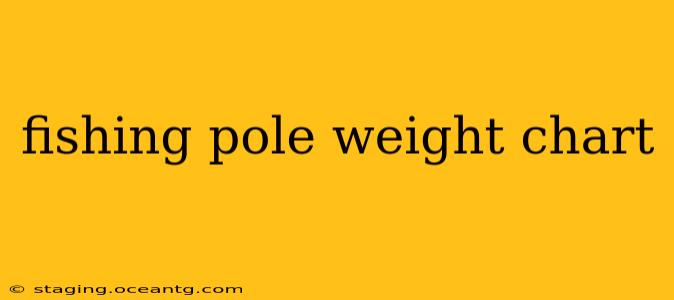Choosing the right fishing pole can feel overwhelming with the variety of weights, materials, and actions available. This guide will break down how to understand fishing pole weight charts and help you select the perfect rod for your fishing style and target species. We'll delve into the crucial aspects of line weight, lure weight, and rod power to ensure you're properly equipped for a successful fishing trip.
What Does a Fishing Pole Weight Chart Tell You?
A fishing pole weight chart, often found on the rod itself or in the manufacturer's specifications, doesn't directly list "weight" in pounds or ounces. Instead, it provides critical information about the rod's capabilities:
-
Line Weight: This indicates the appropriate diameter (measured in pounds test) of fishing line the rod is designed to handle. Using line too light risks breakage; using line too heavy reduces sensitivity.
-
Lure Weight: This specifies the weight range (usually in ounces or grams) of lures or baits the rod can effectively cast and handle without compromising its performance or durability.
-
Power: This describes the rod's backbone and strength. Power ratings generally range from ultra-light to extra-heavy. This dictates the size of fish the rod can comfortably handle and the type of fishing it's best suited for.
How to Interpret Fishing Rod Power Ratings
Understanding the power rating is key to selecting the right rod. Here's a breakdown of common power ratings:
-
Ultra-Light: Ideal for finesse fishing with small lures and light lines targeting panfish or trout.
-
Light: Suitable for smaller bass, trout, and panfish with light to medium lures.
-
Medium-Light: Versatile option for a variety of fish and lure sizes.
-
Medium: A good all-around choice for many fish species and lure types.
-
Medium-Heavy: Excellent for larger bass, pike, and other game fish.
-
Heavy: Designed for powerful fighting fish like muskie, striper, or large saltwater species.
-
Extra-Heavy: Built for exceptionally large and strong fish requiring significant rod power.
What is the difference between power and action?
While power refers to the overall strength of the rod, action describes how the rod bends under pressure. Action is usually described as fast, moderate, or slow. Fast action rods bend primarily in the tip, while slow action rods bend along their entire length. This affects casting distance and sensitivity. The combination of power and action influences the overall feel and performance of the rod.
What Line Weight Should I Use?
The line weight recommendation on the rod is a starting point. Consider these factors when choosing your line:
-
Target Species: Larger fish require heavier line.
-
Fishing Conditions: Strong currents or heavy vegetation might necessitate a thicker line.
-
Lure Weight: The line should be strong enough to handle the weight of your lure.
What Lure Weight Can I Cast?
The lure weight range is crucial for effective casting. Using lures outside this range can lead to poor performance, reduced accuracy, or even damage to the rod.
What if the Lure is Too Heavy?
Casting a lure significantly heavier than the rod's recommendation can overload the rod, causing it to break.
What if the Lure is Too Light?
While not as dangerous as an overly heavy lure, a lure that's too light might not cast well and may not give you optimal sensitivity when detecting bites.
How Do I Choose the Right Fishing Pole Weight?
To choose the right fishing pole weight, consider the following:
-
Type of Fish You’re Targeting: Different fish species require different rod weights and actions.
-
Fishing Location: The type of water (lake, river, ocean) and cover will influence your rod choice.
-
Fishing Technique: Are you using lures, bait, or fly fishing?
-
Personal Preference: Some anglers prefer lighter or heavier rods depending on their casting style and physical strength.
By carefully considering these factors and referring to the fishing pole weight chart, you can select a rod perfectly matched to your needs, enhancing your fishing experience and increasing your chances of a successful catch. Remember, always prioritize safety and use the appropriate gear for the fishing conditions and target species.
